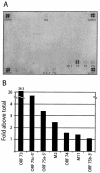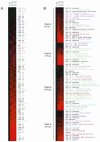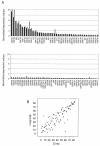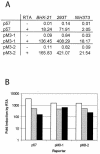Transcription program of murine gammaherpesvirus 68
- PMID: 12970434
- PMCID: PMC228380
- DOI: 10.1128/jvi.77.19.10488-10503.2003
Transcription program of murine gammaherpesvirus 68
Abstract
Murine gammaherpesvirus 68 (MHV-68 [also referred to as gammaHV68]) is phylogenetically related to Kaposi's sarcoma-associated herpesvirus (KSHV [also referred to as HHV-8]) and Epstein-Barr virus (EBV). However, unlike KSHV or EBV, MHV-68 readily infects fibroblast and epithelial cell lines derived from several mammalian species, providing a system to study productive and latent infections as well as reactivation of gammaherpesviruses in vivo and in vitro. To carry out rapid genome-wide analysis of MHV-68 gene expression, we made DNA arrays containing nearly all of the known and predicted open reading frames (ORFs) of the virus. RNA obtained from an MHV-68 latently infected cell line, from cells lytically infected with MHV-68 in culture, and from the lung tissue of infected mice was used to probe the MHV-68 arrays. Using a tightly latent B-cell line (S11E), the MHV-68 latent transcription program was quantitatively described. Using BHK-21 cells and infected mice, we demonstrated that latent genes are transcribed during lytic replication and are relatively independent of de novo protein synthesis. We determined that the transcription profiles at the peak of lytic gene expression are similar in cultured fibroblast and in the lung of infected mice. Finally, the MHV-68 DNA arrays were used to examine the gene expression profile of a recombinant virus that overexpresses replication and transcription activator (RTA), C-RTA/MHV-68, during lytic replication in cell culture. The recombinant virus replicates faster then the parental strain and the DNA arrays revealed that nearly every MHV-68 ORF examined was activated by RTA overexpression. Examination of the gene expression patterns of C-RTA/MHV-68 over a time course led to the finding that the M3 promoter is RTA responsive in the absence of other viral factors.
Figures







Similar articles
-
Rta of murine gammaherpesvirus 68 reactivates the complete lytic cycle from latency.J Virol. 2000 Apr;74(8):3659-67. doi: 10.1128/jvi.74.8.3659-3667.2000. J Virol. 2000. PMID: 10729142 Free PMC article.
-
Murine Gammaherpesvirus 68 ORF48 Is an RTA-Responsive Gene Product and Functions in both Viral Lytic Replication and Latency during In Vivo Infection.J Virol. 2015 Jun;89(11):5788-800. doi: 10.1128/JVI.00406-15. Epub 2015 Mar 11. J Virol. 2015. PMID: 25762743 Free PMC article.
-
Function of Rta is essential for lytic replication of murine gammaherpesvirus 68.J Virol. 2001 Oct;75(19):9262-73. doi: 10.1128/JVI.75.19.9262-9273.2001. J Virol. 2001. PMID: 11533188 Free PMC article.
-
Is murine gammaherpesvirus-68 (MHV-68) a suitable immunotoxicological model for examining immunomodulatory drug-associated viral recrudescence?J Immunotoxicol. 2015 Jan-Mar;12(1):1-15. doi: 10.3109/1547691X.2014.882996. Epub 2014 Feb 10. J Immunotoxicol. 2015. PMID: 24512328 Review.
-
Lytic cycle switches of oncogenic human gammaherpesviruses.Adv Cancer Res. 2007;97:81-109. doi: 10.1016/S0065-230X(06)97004-3. Adv Cancer Res. 2007. PMID: 17419942 Review.
Cited by
-
Zinc finger antiviral protein inhibits murine gammaherpesvirus 68 M2 expression and regulates viral latency in cultured cells.J Virol. 2012 Nov;86(22):12431-4. doi: 10.1128/JVI.01514-12. Epub 2012 Sep 5. J Virol. 2012. PMID: 22951821 Free PMC article.
-
Identification of spliced gammaherpesvirus 68 LANA and v-cyclin transcripts and analysis of their expression in vivo during latent infection.J Virol. 2006 Feb;80(4):2055-62. doi: 10.1128/JVI.80.4.2055-2062.2006. J Virol. 2006. PMID: 16439562 Free PMC article.
-
Induction of protective immunity against murine gammaherpesvirus 68 infection in the absence of viral latency.J Virol. 2010 Mar;84(5):2453-65. doi: 10.1128/JVI.01543-09. Epub 2009 Dec 16. J Virol. 2010. PMID: 20015983 Free PMC article.
-
ORF73-null murine gammaherpesvirus 68 reveals roles for mLANA and p53 in virus replication.J Virol. 2007 Nov;81(21):11957-71. doi: 10.1128/JVI.00111-07. Epub 2007 Aug 15. J Virol. 2007. PMID: 17699571 Free PMC article.
-
Open reading frame 33 of a gammaherpesvirus encodes a tegument protein essential for virion morphogenesis and egress.J Virol. 2009 Oct;83(20):10582-95. doi: 10.1128/JVI.00497-09. Epub 2009 Aug 5. J Virol. 2009. PMID: 19656880 Free PMC article.
References
-
- Chu, S., J. DeRisi, M. Eisen, J. Mulholland, D. Botstein, P. O. Brown, and I. Herskowitz. 1998. The transcriptional program of sporulation in budding yeast. Science 282:699-705. - PubMed
Publication types
MeSH terms
Substances
Grants and funding
LinkOut - more resources
Full Text Sources
Other Literature Sources

